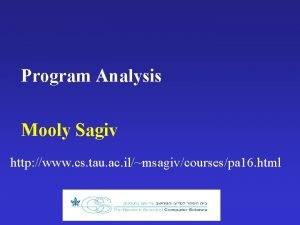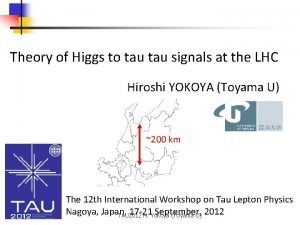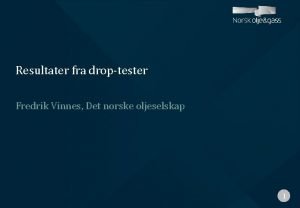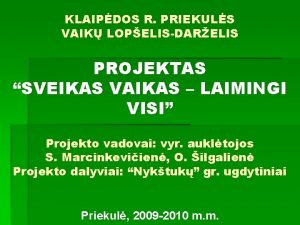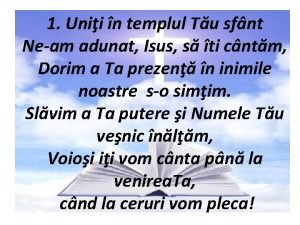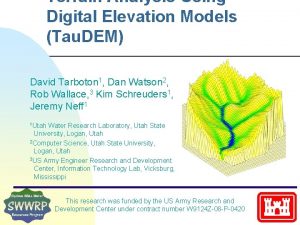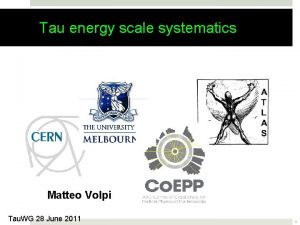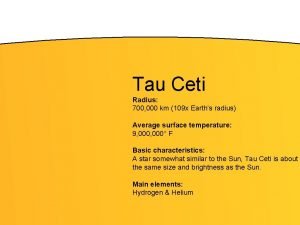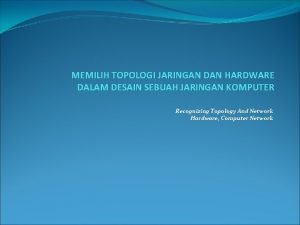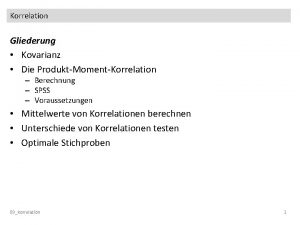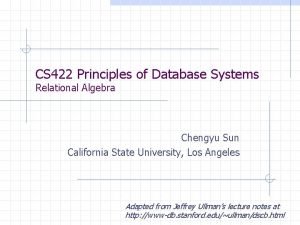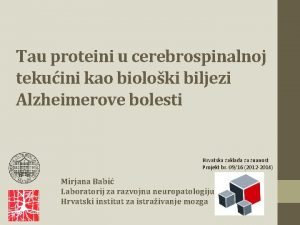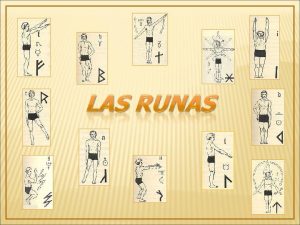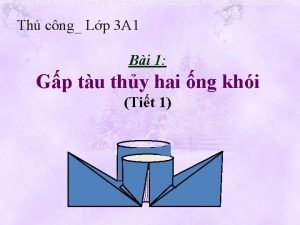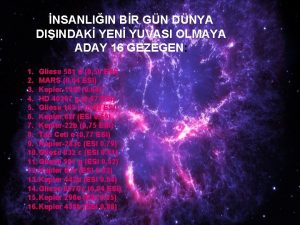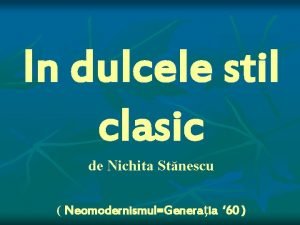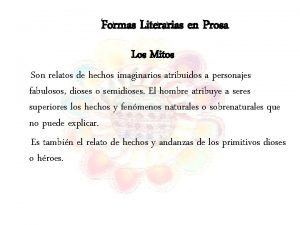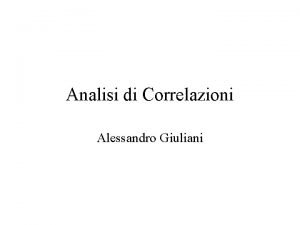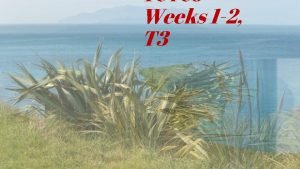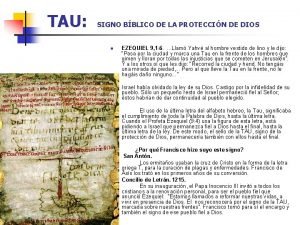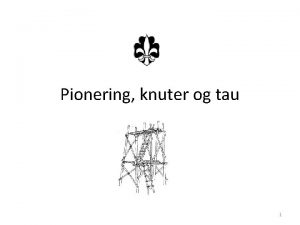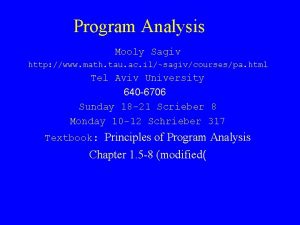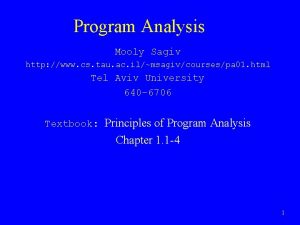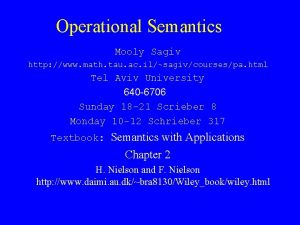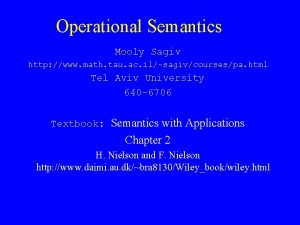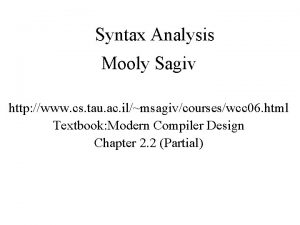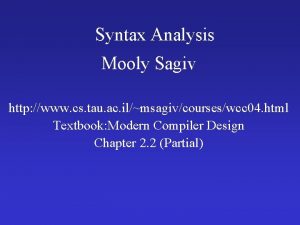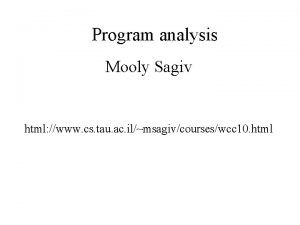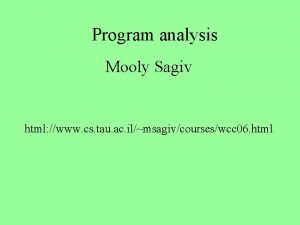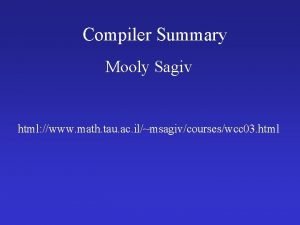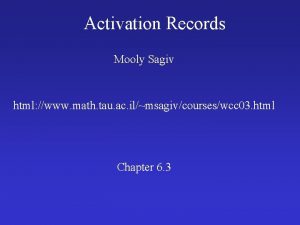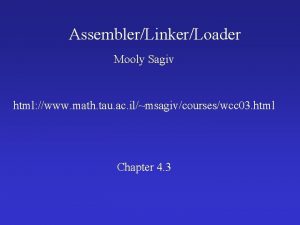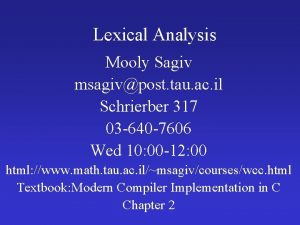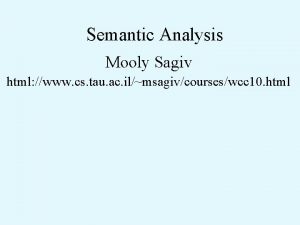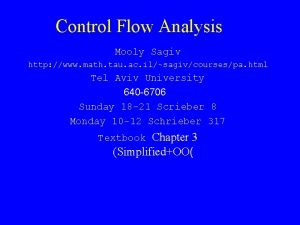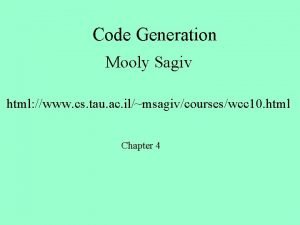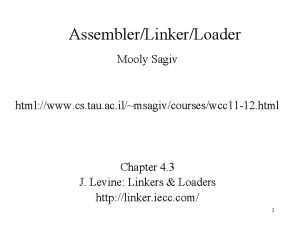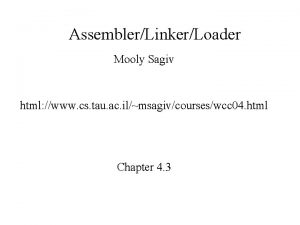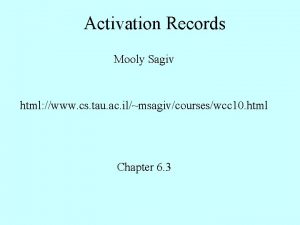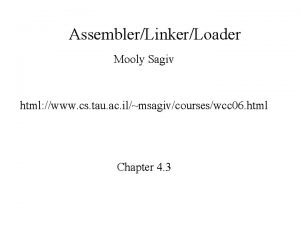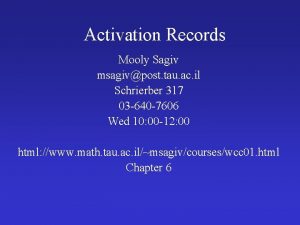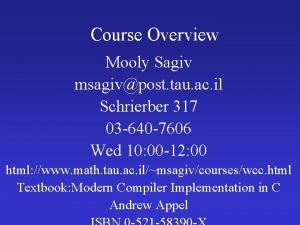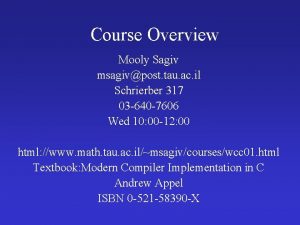Program Analysis Mooly Sagiv http www math tau





![Flow Information in While u u init: Stm Lab* – init([x : = a]l) Flow Information in While u u init: Stm Lab* – init([x : = a]l)](https://slidetodoc.com/presentation_image_h2/1765b732a7ea4aab75c364ae3d4fb932/image-6.jpg)

![Elementary Blocks in While u ]x : = a]l – block(l)= [x : = Elementary Blocks in While u ]x : = a]l – block(l)= [x : =](https://slidetodoc.com/presentation_image_h2/1765b732a7ea4aab75c364ae3d4fb932/image-8.jpg)

![The Power Program ]z : = 1]1; while [x>0]2 do) ]z: = z * The Power Program ]z : = 1]1; while [x>0]2 do) ]z: = z *](https://slidetodoc.com/presentation_image_h2/1765b732a7ea4aab75c364ae3d4fb932/image-10.jpg)
![The System of Equations ]z : = 1]1; while [x>0]2 do ([z: = z The System of Equations ]z : = 1]1; while [x>0]2 do ([z: = z](https://slidetodoc.com/presentation_image_h2/1765b732a7ea4aab75c364ae3d4fb932/image-11.jpg)






![An Example ]x : = a+b]1; [y : = a*b]2; while [x>0]3 do) ]z: An Example ]x : = a+b]1; [y : = a*b]2; while [x>0]3 do) ]z:](https://slidetodoc.com/presentation_image_h2/1765b732a7ea4aab75c364ae3d4fb932/image-18.jpg)






![Example ]x : = 2; ]1 [y : = 4; ]2 [x : = Example ]x : = 2; ]1 [y : = 4; ]2 [x : =](https://slidetodoc.com/presentation_image_h2/1765b732a7ea4aab75c364ae3d4fb932/image-25.jpg)









- Slides: 34

Program Analysis Mooly Sagiv http: //www. math. tau. ac. il/~sagiv/courses/pa. html Tel Aviv University 640 -6706 Sunday 18 -21 Scrieber 8 Monday 10 -12 Schrieber 317 Textbook: Dataflow Analysis Kill/Gen Problems Chapter 2

Kill/Gen Problems u. A simple class of static analysis problems u Generalizes the reaching definition problem u The static information consist of sets of “dataflow” facts u Compute information on the history/future of computations u Generate a system of equations – Use union/intersection to merge information along different control flow paths – Find minimal/maximal solutions

The Reaching Definitions (Revisited( u RDexit (l) = (RDentry (l) - kill) gen – assignments » kill([x : = a]l) ={(x, l’) | l’ Lab{* » gen ([x : = a]l) = {(x, l{( – skip » kill([skip]l) = » gen ([skip]l) = u RDentry (l) = {l’ pred(l)} RDexit(l(’

Remark B #RD (RDentry (l) )= (RDentry (l) - kill(l)) gen(l(

Front-End Information (Reaching Definitions( - The label that S begins u final(S) - The labels that S end u flow(S) - The control flow graph of S u block(l) - The elementary block associated with l u FV(S) - The variables used in S u S*- The analyzed program u init(S)
![Flow Information in While u u init Stm Lab initx al Flow Information in While u u init: Stm Lab* – init([x : = a]l)](https://slidetodoc.com/presentation_image_h2/1765b732a7ea4aab75c364ae3d4fb932/image-6.jpg)
Flow Information in While u u init: Stm Lab* – init([x : = a]l) = l – init([skip]l) = l – init(S 1 ; S 2) = init(S 1( – init(if [b]l then S 1 else S 2) = l – init(while [b]l do S) = l final: Stm P(Lab(* – final([x : = a]l) = {l{ – final([skip]l) = {l{ – final(S 1 ; S 2) = final(S 2( – final(if [b]l then S 1 else S 2) = final(S 1) final(S 2( – final(while [b]l do S) = {l{

Flow Information in While u flow: Lab P(Lab* Lab (* – flow([x : = a]l) = – flow([skip]l) = – flow(S 1 ; S 2) = flow(S 1) flow(S 2) {(l, l’) | l final(S 1), l’ =init(S 2{( – flow(if [b]l then S 1 else S 2) = flow(S 1) flow(S 2) {(l, l’) | l’ =init(S 1)} {(l, l’) | l’ =init(S 2 {( – flow(while [b]l do S) = flow(S) {(l, l’) | l’ =init(S)} {(l’, l) | l’ final(S {(
![Elementary Blocks in While u x al blockl x Elementary Blocks in While u ]x : = a]l – block(l)= [x : =](https://slidetodoc.com/presentation_image_h2/1765b732a7ea4aab75c364ae3d4fb932/image-8.jpg)
Elementary Blocks in While u ]x : = a]l – block(l)= [x : = a]l u ]skip]l – block(l)= [skip]l u ]b]l – block(l)= [b]l

The System of Equations Reaching Definitions
![The Power Program z 11 while x02 do z z The Power Program ]z : = 1]1; while [x>0]2 do) ]z: = z *](https://slidetodoc.com/presentation_image_h2/1765b732a7ea4aab75c364ae3d4fb932/image-10.jpg)
The Power Program ]z : = 1]1; while [x>0]2 do) ]z: = z * x]3; ]x : = x - 1]4 (
![The System of Equations z 11 while x02 do z z The System of Equations ]z : = 1]1; while [x>0]2 do ([z: = z](https://slidetodoc.com/presentation_image_h2/1765b732a7ea4aab75c364ae3d4fb932/image-11.jpg)
The System of Equations ]z : = 1]1; while [x>0]2 do ([z: = z * x]3; [x : = x - 1]4(

Chaotic Iterations for l Lab* do RDentry(l) : = RDexit(l) : = RDentry(init(S*)) : = {(x, ? ) | x FV(S{(* WL= Lab* while WL != do Select and remove an arbitrary l WL if (temp != RDexit(l(( RDexit(l) : = temp for l' such that (l, l') flow(S*) do RDentry(l') : = RDentry(l') RDexit(l( WL : = WL l’

Available Expressions u The computation of a complex program expression e at a program point l can be avoided if: – e is computed on every path to l and none of its arguments are changed – e is side effect free 1; [y : = a*b]2; ]x : = a+b] u A simple example while [y >a+b]3 do) ]a: = a + 1]4; x : = a+b]5( ue can be saved in a temporary variable/register u For simplicity only consider “formal” expressions

The Largest Conservative Solution u It is undecidable to compute the exact available expressions u Compute a conservative approximation u We are looking for a maximal set of available expressions u Example [x : = a +b]1 while [true]2 do [skip]3 u Minimal set of “missed” expressions u The problem is a must problem – An expression e is available at l if e must be computed on all the paths leading to l

Front-End Information (Available Expressions( - The label that S begins u final(S) - The labels that S end u flow(S) - The control flow graph of S u block(l) - The elementary block associated with l u AExp(S) - The set of formal expressions in S u FV(e) - The variables used in the expression e u S*- The analyzed program u init(S)

The System of Equations Available Expressions

Remark B #AE (AEentry (l) )= (AEentry (l) - kill(l)) gen(l(
![An Example x ab1 y ab2 while x03 do z An Example ]x : = a+b]1; [y : = a*b]2; while [x>0]3 do) ]z:](https://slidetodoc.com/presentation_image_h2/1765b732a7ea4aab75c364ae3d4fb932/image-18.jpg)
An Example ]x : = a+b]1; [y : = a*b]2; while [x>0]3 do) ]z: = z * x]4; ]x : = x - 1]5 (

Chaotic Iterations for l Lab* do AEentry(l) : = AExp(S(* AEexit(l) : = AExp(S(* AEentry(init(S*)) : = WL= Lab* while WL != do Select and remove an arbitrary l WL if (temp != AExit(l(( AEexit(l) : = temp for l' such that (l, l') flow(S*) do AEentry(l') : = AEentry(l') AEexit(l( WL : = WL l’

Dual Available Expressions u It is possible to compute available expressions representing those expressions that may-not-be available u An expression e is not-available at l if e may-not be computed on some of the paths leading to l u This is may problem u The smallest set is computed

The System of Equations Dual Available Expressions

Backward(Future) Data Flow Problems u So far we saw two examples of analysis problems where we collected information about past computations u Many interesting analysis problems we are interested to know about the future u Hard for dynamic analysis !

Liveness Data Flow Problems u. A variable x may be live at l if there may be an execution path from l in which the value of x is used prior to assignment u An Example: [x : = 2; ]1 [y : = 4; ]2 [x : = 1; ]3 if [ y>x]4 then [z : =y]5 else [z : = y*y]6 [x : =z]7 u Usage of liveness – – register allocation dead code elimination more precise garbage collection uninitialized variables

The System of Liveness Equations
![Example x 2 1 y 4 2 x Example ]x : = 2; ]1 [y : = 4; ]2 [x : =](https://slidetodoc.com/presentation_image_h2/1765b732a7ea4aab75c364ae3d4fb932/image-25.jpg)
Example ]x : = 2; ]1 [y : = 4; ]2 [x : = 1; ]3 if [y>x]4 then ] z : =y]5 else ]z : = y*y]6 ]x : =z]7

Chaotic Iterations for l Lab* do LVentry(l) : = LVexit(l) : = for l final(S*) do LVexit(l) : = WL= Lab* while WL != do Select and remove an arbitrary l WL if (temp != LVentry(l(( LVentry(l) : = temp for l' such that (l’, l) flow(S*) do LVexit(l') : = LVeexit(l') LVentry(l( WL : = WL l’

Characterization of Dataflow Problems u Direction of flow – forward – backward u Initial value u Control flow merge – May(union( – Must (intersection( u Solution – Smallest – Largest

Backward (Future)Must Problem Very Busy Expressions u An expression e is very busy at l if its value at l must be used in all the paths from l u Example program if [a>b]1 then [x : =b-a]2 [y : = a-b]3 else [y : =b-a]4 [x : = a-b]5 u Usage of Very Busy Expressions – Reduce code size – Increase speed u Find the largest solution

The System of Very Busy Equations

Chaotic Iterations for l Lab* do VBntry(l) : = AExp(S(* VBexit(l) : = AExp(S(* for l final(S*) do VBexit(l) : = WL= Lab* while WL != do Select and remove an arbitrary l WL if (temp != VBentry(l(( VBentry(l) : = temp for l' such that (l’, l) flow(S*) do VBexit(l') : = VBeexit(l') VBentry(l( WL : = WL l’

Bit-Vector Problems u Kill/Gen problems are also called Bit-Vector problems u Y = (X - Kill) Gen u Y[i]=(X[i] Kill[i]) Gen[i[ u Every component can be computed individually (in linear time(

Non Kill/Gen Problems u truly-live variables – A variable v may be truly live at l if there may be an execution path to l in which v is (transitively) used prior to assignment in a print statement u May be “garbage” (uninitialized( – A variable v may be garbage at l if there may be an execution path to l in which v is either not initialized or assigned using an expression with occurrences of uninitialized variables

Non Kill/Gen Problems(Cont( u May-points-to – A pointer variable p may point to a variable q at l if there may be an execution path to l in which p holds the address of q u Sign Analysis – A variable v must be positive/negative l if on all execution paths to l v has positive/negative value u Constant Propagation – A variable v must be a constant at l if on all execution paths to l v has a constant value

Conclusions u Kill/Gen Problems are simple useful subset of dataflow analysis problems u Easy to implement
 Mooly sagiv
Mooly sagiv Higgs to tau tau
Higgs to tau tau Opening meeting karakia
Opening meeting karakia Karakia whakamutunga kia tau
Karakia whakamutunga kia tau Elastisk tau biltema
Elastisk tau biltema Labas rytas tau galvyte
Labas rytas tau galvyte Uniti in templul tau sfant versuri
Uniti in templul tau sfant versuri Tau 7 for sale
Tau 7 for sale Taudem
Taudem Tau energi
Tau energi Tau ceti distance to earth
Tau ceti distance to earth Desain topologi jaringan
Desain topologi jaringan Produkt moment korrelation
Produkt moment korrelation Sigma minusculo
Sigma minusculo Delta relational algebra
Delta relational algebra Nkotn
Nkotn Delta tau alpha honor society
Delta tau alpha honor society Tau proteini
Tau proteini Tau beta sigma constitution
Tau beta sigma constitution Tali ui sepitema
Tali ui sepitema Runa laf
Runa laf Tizen tau
Tizen tau Gấp tàu thủy hai ống khói
Gấp tàu thủy hai ống khói Sen tau
Sen tau Tau ceti e
Tau ceti e Neomodernismul
Neomodernismul Leyenda en guaraní corto
Leyenda en guaraní corto Tau tangles
Tau tangles Kendall's tau formula
Kendall's tau formula Upper ngau tau kok estate
Upper ngau tau kok estate Death whakatauki
Death whakatauki Ayat alquran tentang kematian
Ayat alquran tentang kematian Tau signo
Tau signo Mama mamyte as tave myliu
Mama mamyte as tave myliu Langspleis tau
Langspleis tau
